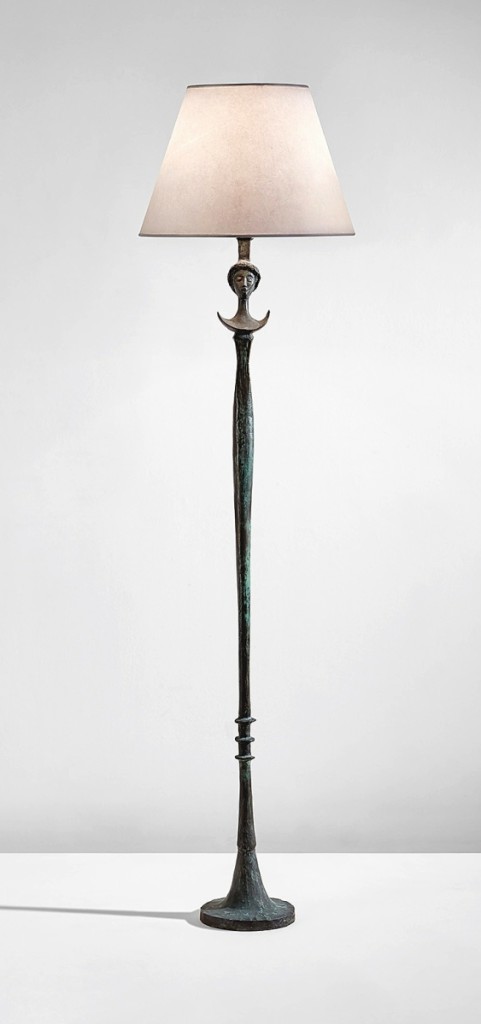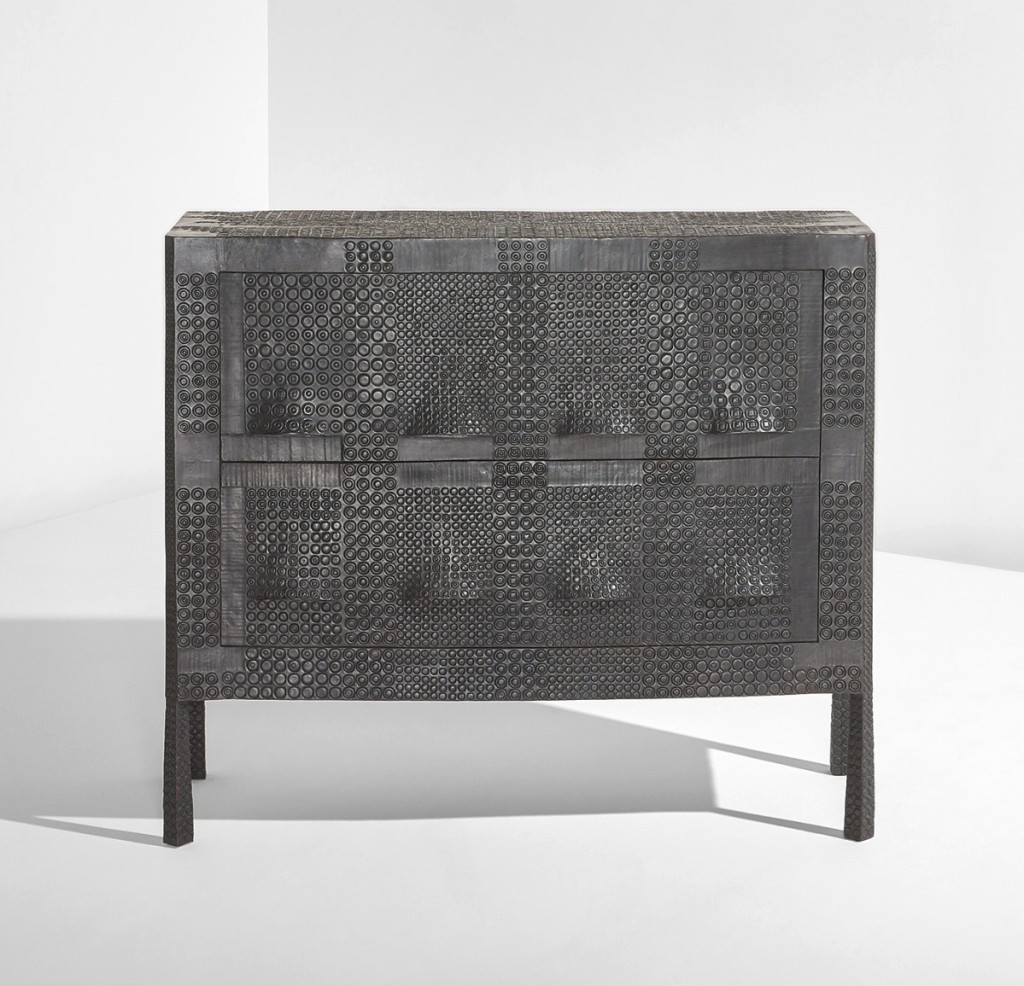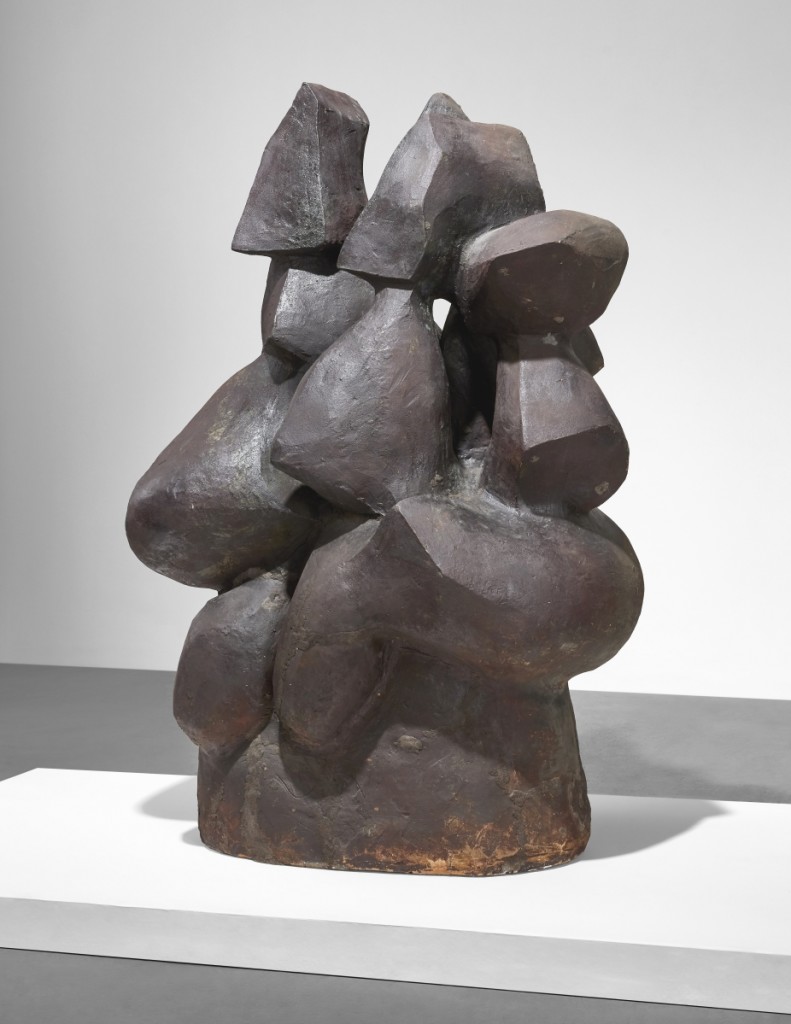
Peter Voulkos, “Black Bulerias,” 1958, set a new auction record for the artist, realizing $1,264,200.
Review by W.A. Demers, Photos Courtesy Phillips
NEW YORK CITY – Phillips’ design auction on December 9 sets new auction records for Peter Voulkos and Vladimir Kagan in a sale that totaled $5.1 million, was 86 percent sold by lot and 95 percent by value.
Cordelia Lembo, the firm’s head of design, New York, stated, “We are thrilled to close out 2020 with a bang, as our design sale exceeded estimates across the board. Leading the sale was Peter Voulkos’ monumental ‘Black Bulerias,’ which achieved a remarkable $1,264,200. This marks the third time Phillips has broken the record for Twentieth Century American ceramics at auction, with the previous record set by Voulkos’ ‘Rondena’ in 2017. Vladimir Kagan’s rare ‘Contour’ rocking chair, with embroidery by Erica Wilson, saw tremendous enthusiasm and exceeded its estimate tenfold, setting a new world record for the designer.”
Property from a private Midwestern collection, “Black Bulerias” is a 1958 piece of stoneware constructed from paddled, wheel-thrown and slab elements, brushed slip, clear glaze, epoxy. The 63-by-44-by-41-inch work had provenance to a couple of California private collections until it was acquired by the consignor through art dealer Wanda Hansen in 1982. Its exhibition history included “Ceramics, Sculpture and Paintings by Peter H. Voulkos” at the Pasadena Art Museum in 1958-59; “Peter Voulkos: Sculpture, Painting, Ceramics,” Felix Landau Gallery, Los Angeles, in May 1959; “Première Biennale de Paris,” Musée d’Art Moderne de la Ville de Paris, Paris, in October 1959; and “Sculpture and Painting by Peter Voulkos,” the Museum of Modern Art, New York City, in February/March 1960. In a catalog essay titled “Rhythm King,” playing on the sculpture’s fast-dance inspiration, Glenn Adamson wrote, “All of Voulkos’ ambitions are present in this powerful work: geological force, medium-specific innovation, monumentality, sculptural intelligence and structural complexity. Its importance derives partly from the circumstances of its making. In 1958, the artist was just arriving at the summit of his career-a short period that lasted only for another two years, when he was obliged to leave Los Angeles behind to teach in Berkeley.”
The sale also set a new auction record for Vladimir Kagan, whose rare “Contour” rocking chair, with embroidery by Erica Wilson, exceeded its estimate tenfold and brought $132,300. From the collection of the designer and having then descended to the consignors, the circa 1955 walnut chair had been estimated just $10/15,000. In a catalog essay, Suzanne Slesin, whose mother was a friend of the designer’s mother, wrote, “There is hardly a survey on the history of midcentury furniture design that does not include the work of Vladimir Kagan, the talented, debonair and prolific designer who died in 2016 at the age of 88.”
Designed circa 1933 and later cast, an Alberto Giacometti “Figure” floor lamp of patinated bronze and with paper shade, 61 inches tall, realized $277,200, above its high estimate. Its base was impressed A. Giacometti, DG, and 056 and it was accompanied by a certificate of authenticity from the Comité Giacometti.
Acquired directly from the designer by the consignor, a “Commode Galuchat,” 2013, of patinated bronze by Ingrid Donat took $214,200. Produced by Carpenters Workshop Gallery, it was cast by Markovstudio, Sofia, Bulgaria, as number 3 from the edition of eight plus four artist’s proofs. Swedish-born, Donat has lived and worked in Paris since 1975, when she moved there to study sculpture at the École des Beaux-Arts. Encounters with Sylva Bernt (the companion of André Arbus) and Diego Giacometti introduced her to the art of cast bronze furniture.
Fetching $189,000 was Marc Newson’s “Orgone Chop Top” coffee table. Designed in 1990 and produced in 2004, the piece of polished aluminum, painted aluminum and glass measured 13-3/8 by 63 by 28 inches. The piece blends Newson’s exploration of aluminum as a material for furniture that he began with his iconic “Lockheed Lounge” as well as his fascination with automobile aesthetics. Catalog notes explain that the title “Chop Top” refers to the act of transforming a car into a convertible by sawing the top off. Here, he “cuts” the tabletop in half and places glass on the top so that one can see the interior of the table.
Property from a private Swiss collection, a Gio Ponti (Italian, 1891-1979) coffee table, circa 1948, of brass, marble and glass, together with a certificate of expertise from the Gio Ponti Archives, finished at $88,200, a bit below its high estimate. Among the most prolific talents to grace Twentieth Century design, Ponti defied categorization. Though trained as an architect, he made major contributions to the decorative arts, designing in such disparate materials as ceramics, glass, wood and metal. Traditional materials, such as marble and wood, were reimagined in original, unconventional ways. From the same collection and bringing the same price was a pair of Gio Ponti “Distex” armchairs, circa 1953, in brass with fabric upholstery. They were manufactured by Cassina, Meda, Italy
Property from the collection of Pamela K. And William A. Royall Jr, a Joris Laarman “Cumulus” table, 2010, of Striato Olimpico marble comprised a large table, 13¾ by 72½ by 31½ inches, and a smaller table, 13¾ by 18 by 13½ inches. It sold for $75,600.
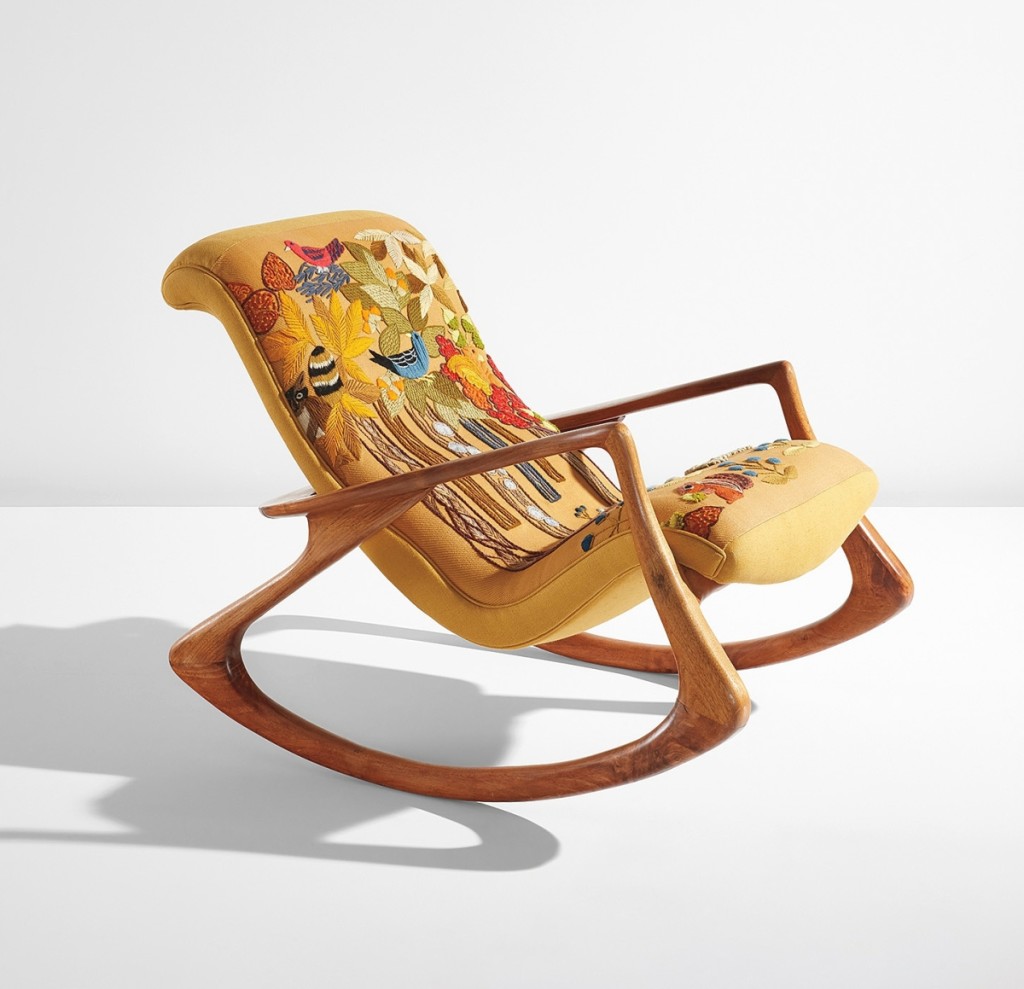
An auction record was set for Vladimir Kagan’s “Contour” rocking chair, model no. 175F, 1955. It was bid to $132,300.
A daybed model that was exhibited at the 1923 Salon d’Automne, Paris, Pierre Chareau’s “Tulip” model no. MP 102, circa 1923, of rosewood, rosewood-veneered wood and fabric, commanded $69,300. For a period spanning approximately a dozen years, Chareau designed exquisite interiors for the progressive bourgeoisie of interwar Paris. Chareau and his wife Dollie belonged to this cultivated set, who were as forward-thinking in their taste for art, music, theater and film as they were in their politics. While his avant-garde designs embodied Modernism, they remained luxurious, tied to the high-quality, labor-intensive craftsmanship that had set French decorative arts apart since the Eighteenth Century.
As part of the overall design sale, Phillips offered a selection of nearly 30 Art Nouveau ceramics from the collection of New York City gallerist Jason Jacques. Arts du Feu: Works from the Collection of Jason Jacques included superlative examples of fin-de-siècle French ceramics, when undulating vegetal and natural forms along with pioneering new techniques in stoneware and earthenware created a new class of artistic ceramics. Among these were 17 works by the ceramist Pierre-Adrien Dalpayrat, alongside rare works by Ernest Chaplet, Edmond Lachenal, Ernest Bussière, Henri de Vallombreuse and Taxile Doat. Also included were three works by American turn-of-the-century master ceramist George Ohr, all previously from the collection of Robert A. Ellison Jr in their first time being offered at auction.
“It was our pleasure to have the opportunity to work with Jason Jacques this season, and his collection of remarkable turn-of-the-century ceramics was highlighted by George Ohr’s ‘Blistered Vase,’ which achieved $37,800,” said Lembo. “The lone American ceramist represented in the collection, Ohr is considered a singular genius with a whimsical technique and daring that led him to anticipate by decades the expressive breakthroughs made by such figures as Peter Voulkos and Ken Price. Ohr often created untraditional forms that twisted and contorted in unexpected ways. He also experimented greatly with glazing techniques, such as his blistering effect in which he purposefully burst glaze bubbles to produce a scaley and delicate surface texture. Reaching $32,760 was Ohr’s “Pot with snakes,” circa 1895, the glazed earthenware piece standing 5¼ inches and its underside impressed “G.E. Ohr/Biloxi.”
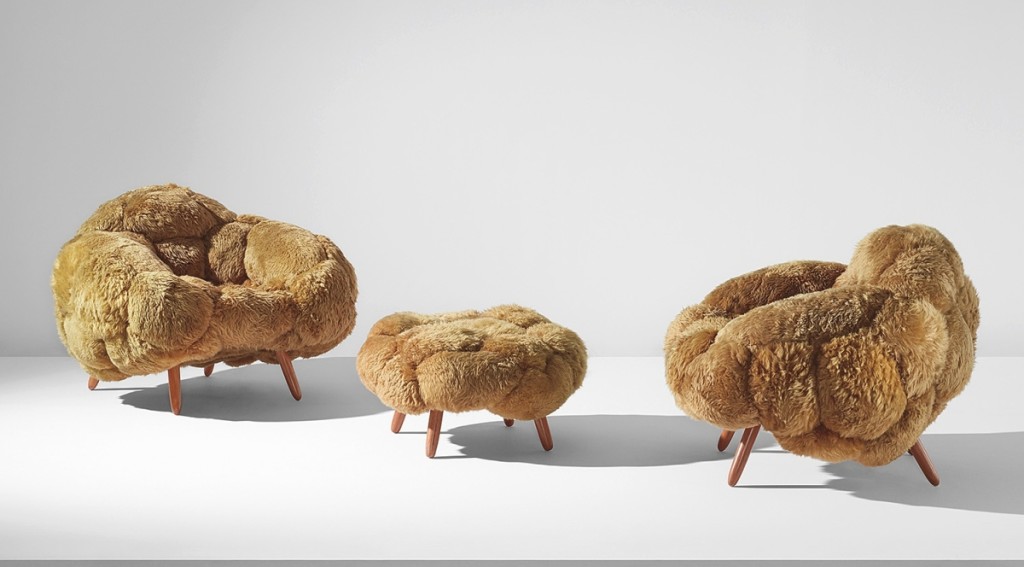
By Fernando and Humberto Campana, this pair of “Bolotas” armchairs and ottoman, 2015, settled at $107,100.
A top selling work by Dalpayrat was a monumental vase, circa 1900, exhibiting high and low-fired copper-oxide glazes. At 41½ inches high, it was bid to $17,640. Known for his pioneering oxblood glazes and vegetal and marine life forms, Dalpayrat was relatively unknown until the age of 45. He worked exclusively in stoneware after his successful debut of dappled oxblood or “Dalpayrat Red” glaze in 1892. The signature glaze is dappled or veined with greens, blues and yellows, and appears on pieces in the form of gourds, fruits and shapes derived from Japanese bottles.
Summing up the sale, Lembo stated, “With such strong results in both London and New York this fall, it is clear that the demand for Twentieth and Twenty-First Century design remains solid and we look forward to our next sales in 2021.”
Prices given include the buyer’s premium as stated by the auction house. For information, 212-940-1200 or www.phillips.com.

